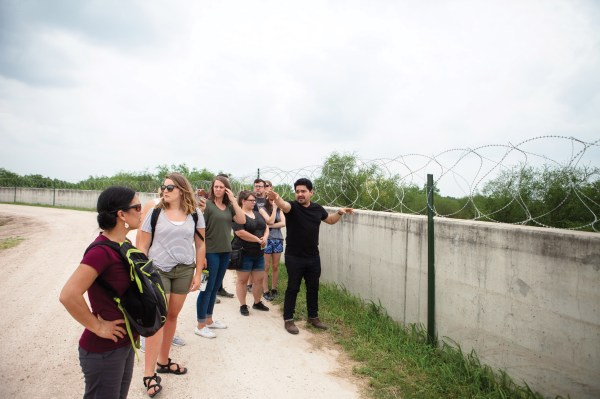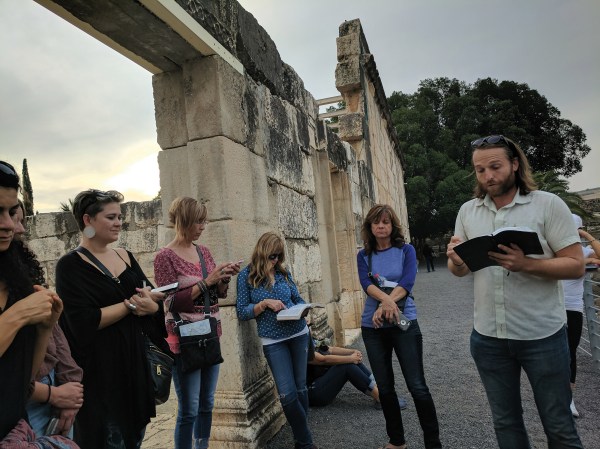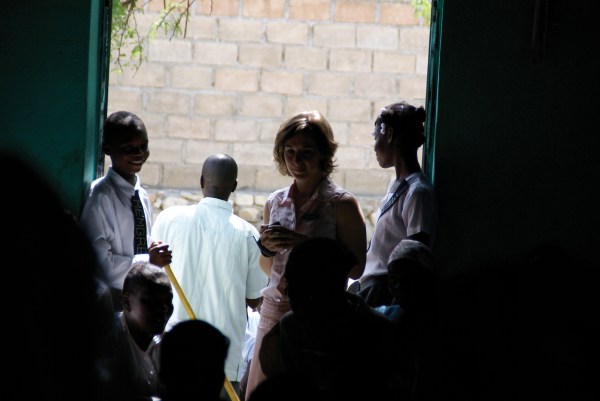In the early years after its founding in 2004, Hands and Feet Project was climbing a steep learning curve as it sought to help vulnerable children in southern Haiti. Founded by then-members of the popular Christian band Audio Adrenaline, the Franklin, Tennessee-based group was, in most other ways, a typical upstart missions organization. It was grappling with the ins and outs of running a nonprofit, navigating government bureaucracies in two countries, raising funds to build children’s homes, and figuring out how to care for the abandoned kids who would occupy them.
Like many organizations, Hands and Feet Project brought in short-term volunteer teams. Twenty people might fly from the United States to Haiti to dig a ditch and paint some buildings on the ministry’s property, while equal numbers of Haitians stood outside the gates looking for work. Visitors stayed on the same property where sponsored children lived and could spend hours befriending and playing with the kids.
After the earthquake that leveled much of Port-au-Prince and surrounding communities in 2010, the ministry began reevaluating its approach to helping children. In particular, leadership asked what they could do to address the root causes of child abandonment, such as poverty, joblessness, and broken families. At the same time, the missions community in North America was being roiled by critiques of its poverty-fighting efforts and, in particular, of the short-term missions industry—due in large part to the success of the bestselling 2009 book When Helping Hurts. Those critiques reached the ears of Hands and Feet’s leadership.
“It took us a while to get our head up out of the sand,” said executive director Andrea McGinniss.
Eventually, the ministry launched an ambitious plan to rework its short-term missions program into one that poured more into the local economy and emphasized experience and learning over trying to “do” something tangible. It secured generous help from a church in Alabama to build a “guest village” with a boutique hotel feel, boasting ocean views and hammock-strung balconies and manicured lawns. It restructured its team itineraries to downplay service projects and give equal, if not greater, weight to rest and exploring Haiti’s culture and natural beauty. It made sure visiting teams were eating—and eating well—at local restaurants, employing local tour guides to scale Haiti’s mountains and snorkel off its Caribbean beaches.
“There are really gorgeous places in Haiti, and you can rest here. You can retreat and Jesus is here and you can spend time with him,” McGinniss said. “It doesn’t have to always just be this mentality that I am going to go and suffer; I’m going to keep my head down and stay in this facility and sacrifice and work and martyr.”
Significantly, Hands and Feet Project chose to put some distance between travelers and the at-risk youth by locating its new guest village down the road from the children’s homes. Frequent visits from hundreds of yearly volunteers were disrupting the children’s lives and were confusing children who already struggled with attachment issues. “It really wasn’t healthy,” McGinniss said. The new arrangement still allowed teams to interact with the children but in more structured and limited ways.
The change was not well received.
When Ikondo, as the guest house is called, opened for business in 2017, “a lot of really passionate supporters left,” McGinniss said. “They weren’t going to get to spend every day with the kid they had gotten to know.” She estimated that as many as 25 percent of the ministry’s regular visitors stopped coming. “It challenged the mentality of, ‘I want to come down. I want to hold babies. I want to have a feel-good moment.’ ”
Short-term mission trips (STMs), both domestic and international, elicited controversy well before their boom in popularity in the 1980s and 1990s. Many in the missions community saw them initially as little more than a recruiting tool for full-time missionary service. But in their rapid growth—various estimates place the number of short-termers around 2 million per year in the US alone—STMs suddenly appeared like a threat to longer-term work and were eventually embraced as an alternative missions strategy altogether.
Then something shifted about a decade ago, as a single chapter in When Helping Hurts, a book by Covenant College professors Brian Fikkert and Steve Corbett, became the first of a wave of popular critiques implicating STMs as causes of harm in the materially poor communities they aimed to help. (Bob Lupton’s Toxic Charity was also among them. Ahead of the curve and somewhat overlooked was David Livermore’s 2006 book, Serving With Eyes Wide Open.)
Ever since, the debate and self-flagellation surrounding STMs has been particularly loud. Critics have called on churches to cancel trips, to make a matching investment in local ministry before taking more trips abroad, or to sap the self-importance from trips by rebranding them with names like “vision trips” or “listening trips.” Churches and missions organizations, of course, have responded in kind, publishing listicles and memes and articles on the enduring merits of STMs—albeit often qualified now with phrases like “when done right.”
But after so much debate, what does a trip done right even look like anymore? McGinniss believes that for most people who travel on mission trips, “their hearts are really good” and they do care about their impact. But “if you want to measure your trip by impact,” she said, “is that the impact for you or for the nation or for the organization you’re coming to serve?”
Organizations like Standards of Excellence in Short-Term Mission (SOE) have made noble and influential efforts to establish best practices in an activity that, by conservative estimates, American Christians alone spend billions of dollars on per year. But if Hands and Feet Project’s experience is an indication, there is far from agreement about which kinds of one- or two-week travel experiences deserve to be elevated as something other than run-of-the-mill tourism. If anything, there is a growing willingness among some evangelicals—long afraid of short-term missions being confused with tourism—to embrace virtually any kind of travel as a tool for the kingdom.
From their vantage point in the Rio Grande Valley, the Moya family has seen the shift in local and foreign missional travel firsthand. More accurately, they’re helping to drive it.
Their South Texas church has received short-term mission teams for 25 years. Many of them hopped over the border into Mexico, a popular and low-cost option for groups wanting to serve abroad.
“I grew up in the short-term mission world, but I was on the receiving end,” Yonathan Moya said. Missionaries regularly visited his parents’ church in Pharr, Texas, and even built his grandparents’ church in northern Mexico. He often served as a Spanish translator for the teams. “I had this really glamorous view of what being a missionary was.”
While studying missions at Bethel University in Indiana, Moya took a study trip to China, immersing himself for weeks in the language and culture. There was little emphasis on projects, he said, and he left with a respect for the country.
Moya moved to the Midwest, but the visit to China informed him and his brother, Jordan, when they took a road trip together in 2017 along the Texas-Mexico border to rediscover where they had grown up. The brothers were shocked at how much they learned—and at how their experiences hosting short-term teams had shaped their perception of themselves and of the region as somehow deficient, rather than as a place where God was moving.
So last year they joined with their family to found Border Perspective, a Christian advocacy organization that brings church groups and individuals to the border to see for themselves an American experience starkly different from their own. It put the Moyas back in the role of hosting short-term volunteers. But as immigration and the harrowing stories of asylum-seekers have come to dominate political discourse in the US, these trips have taken a new form: visitors wanting to spend more time on their own side of the border to better understand the complexities of challenges in their own country.
“I didn’t want teams to come into a region and just repair a roof or do a service project,” Moya said. “I wanted to engage them in the realities and the difficulties that people on the border are experiencing every day.”
The Moyas host service-learning trips that blend activities like volunteering at immigrant shelters with educational components like lessons about the region’s commerce and Latin American cultures, and tours of border crossings and the harsh regional terrain. They also run shorter, more immersive trips that include meetings with border officials and ministry leaders.
 Jon Stegenga / Border Perspecitve
Jon Stegenga / Border PerspecitveChristian border exposure trips are not new. They first appeared in the 1980s, sparked by interest in the Sanctuary movement, which joined hundreds of congregations across denominational lines to advocate for Central American refugees fleeing civil war. Such trips, run by organizations like Tucson, Arizona-based BorderLinks, drew heavily from mainline Protestants at the time.
Today, the flood of mostly Central American asylum seekers at the border—and its accompanying humanitarian crisis of separated families and overcrowded detention centers—has captured national attention. Public figures and media personalities of all stripes have flocked to the border to portray it with their respective spin. Evangelical pastors, church groups, and other leaders—torn between dueling commitments to the rule of law and to compassion toward the sojourner—are seeking to sort through the complexities themselves by traveling to the border on immersive “vision trips” or “border encounters.”
When Shon Young took the job four years ago as pastor for missions and outreach at City Church Del Rio in Del Rio, Texas, things were slow. Mexico’s reputation for violence was keeping church teams away from the border. Then came 2018 and 2019, when recordings leaked of children crying at immigrant detention centers and apprehensions by Customs and Border Patrol surged.
Now Young receives requests to host visitors from as far away as the Midwest and the Northeast and as nearby as San Antonio. People want to see what’s going on, he said. Some come ready to help; others are skeptical of what’s actually happening at the border. He takes volunteers to visit an immigrant shelter his church helps run, where visitors meet migrant families who are often receiving their first showers in days, their first bed and hot meal in weeks.
“By the end you see a change” in the volunteers, Young said. Some ask how they can continue to help. On a day when CT visited Young in Del Rio, a Spanish teacher from Illinois was asking how he could connect with immigration lawyers back home to volunteer as a translator.
I
t is a decades-old criticism that STMs do more for the participants than they do for the host community. But the argument is so widespread that it has come full circle, becoming a marketing mantra itself for short-term travel.
Brian Howell, an anthropologist at Wheaton College, noticed that many of his students spoke of their trip experiences in similar ways no matter where they had traveled. (“They ministered to us more than we ministered to them.”) Howell began researching the culture of short-term missions and published his findings in a book, Short-Term Mission: An Ethnography of Christian Travel Narrative and Experience.
From the smallest ministries to large organizations like the Southern Baptists’ International Mission Board, proponents unabashedly tout the power of STMs to change travelers’ lives and equip them for further kingdom service.
But if one of the chief goals of STMs is a changed participant, just how that participant should change is far less obvious. STM proponents and leaders emphasize to varying degrees the value of travel to generate passion for evangelism and missions or to strengthen spiritual disciplines. What’s the desired change, however, if a trip includes very little service or if language and cultural barriers preclude any serious efforts at evangelism? Or what if the trip is a “vision trip” in the most traditional sense, where nonprofits lead major donors and influential church leaders on a tour through their programs with the explicit aim of securing investment?
“A vision trip is designed to remove all of the opportunities to feel like the great white hope or the hero,” said Dan Haseltine, founder of Blood:Water, which works in East Africa on clean water projects and combating HIV/AIDS. Beyond loosening purse strings, Haseltine, who also manages major donations for the organization, wants his ministry’s vision trips to change perceptions about African poverty—highlighting the ability of Africans to solve their own problems by exposing visitors to African-born success stories. “We want them to see the winning team.”
Howell, the Wheaton professor, points out that even the best-designed learning trips and mission partnerships don’t completely erase the risk of overconfidence. “A week or 10 days is a very short amount of time,” Howell said, cautioning anyone with such brief exposure against overly warm feelings about a given project or ministry.
Still, he thinks the impulse for Americans to look outside their own culture is a good one, especially if their aim is to become more informed. “That’s a move of the Holy Spirit as far as I’m concerned,” he said.
And particularly for ministries addressing the most intractable social problems—broken immigration systems, for instance, or centuries-old entrenched poverty and conflict—the explicit aim of short-term visits is often to turn tourists into informed advocates.
“Mercy and compassion ministry often leads Christians to become the best advocates for structural changes, bringing their Christian convictions into the arena of public policy and urging elected officials to adjust policies that are limiting the vulnerable from fully flourishing,” Matthew Soerens, US director of church mobilization for World Relief, said in an email. “Learning trips are often the first step toward this sort of actual relationship.”
That is at least one goal of the border encounter trips that Ciudad Nueva, a Christian community development organization in El Paso, began hosting this year. Many participants come to learn how to improve their ministry to immigrants back in their own communities. But the organization also wants guests to have a visceral experience that will stick with them and perhaps help change how evangelicals talk about immigration and immigrants.
Christin Taylor, a writer from Pennsylvania, came as part of a team of Wesleyan Church leaders visiting Ciudad Nueva in April. In a church sanctuary lined with green cots and smelling of sweat and urine, she sat with a young Guatemalan mother and her three-year-old daughter, part of a group of newly arrived families Border Patrol had dropped off at the makeshift migrant shelter. Taylor talked with the mother, who had been a schoolteacher, and sketched pictures on a notebook with the girl.
 Hailey Mitsui / Global Immersion
Hailey Mitsui / Global ImmersionTaylor had long believed immigration reform was the chief way to address the migrant crisis at the border. But after a week of hearing stories directly from migrants, as well as from Border Patrol representatives and other ministry leaders, Taylor began pitching articles to Christian publications with a more nuanced view. “Yes, we must secure our borders and also create a nimble system that makes it more humane for those seeking asylum,” she told CT. “However, the long-term solution must be the economic and political stabilization of Central America, so that these precious families don’t have to leave their homes at all.”
Some ministries aim to spark a passion for justice among trip participants while helping them develop wisdom in their activism. The Global Immersion Project, a Christian organization that trains churches and individuals in peacemaking, runs immersion trips as part of a larger curriculum. Participants take a five-week online course on the history of particular global conflicts before traveling either to the California-Mexico border or to Israel-Palestine to meet the people affected. The trips are a “catalytic moment,” said founding co-director Jer Swigart.
Afterward participants spend anywhere from 10 weeks to 10 months in online and in-person small groups discussing with fellow participants how they’re pursuing peacemaking in their own communities. They are encouraged not to run out and start their own project but to come under the leadership of someone already doing the work in their community. It takes a long time to “disciple the colonizing impulse out of people,” Swigart said. Staff also try to rein in participants’ impulse to speak out in knee-jerk ways, particularly on social media, he explained. “Your little feel-good explosion could set back an entire congregation or city.”
Even for organizations with far more apolitical goals, a certain type of advocacy is clearly a hoped-for outcome of hosting visiting groups. McGinniss, the director at Hands and Feet Project, said her organization wants visitors to immerse themselves in Haiti in part so they can go out and change perceptions about the country. “Yes, you’re going to drive through some pretty rough places. But there are also a lot of contrasting beautiful places,” she said. “It would be a shame to go home from Haiti and not have the opportunity to explore some of the most wonderful landscapes and scenic views there.”
Michelle Chang’s outlook on travel changed dramatically when she took an immersive trip to Haiti.
When she was in college years earlier, the Oregon native had gone to the Dominican Republic on her first church mission trip. She returned to the Caribbean nation two summers in a row as an intern, helping coordinate other American teams that flocked there.
Chang is quick to say the experience changed her life and that mission trips can be enormously valuable. But it left her wondering why more lives had not changed beyond her own.
Then in 2009, she and her new husband traveled to northern Haiti on a vision trip focused mostly on listening and learning about what was happening in communities there. Their mission hosts did not assign them a big service project, but they did introduce them, yes, to When Helping Hurts.
That trip “showed me that another way was possible and still just as powerful for all involved,” Chang said.
 Intentional Travelers
Intentional TravelersNow Chang and her husband, Jedd, run Intentional Travelers, a blog promoting “transformational travel” characterized by a slower pace, longer-term stays, and learning through meaningful cross-cultural exchanges.
“It’s not travel for the sake of rest, entertainment, or self-indulgence,” Chang said by email.
The self-described nomadic couple lives abroad as much as six months a year, teleworking while practicing what they preach. They still give to the ministry they visited in Haiti, as well as to an Oregon refugee ministry Michelle volunteers with.
“As Christians, when we step outside our bubble, Jesus works through that experience to renew our minds, transform our hearts, and make us better ‘hands and feet’ to serve his people,” Chang said. “If every American Christian could experience a developing country for themselves, it would bring us closer to God and it would transform the church in America in a way that we sorely need.”
But is $3,000 spent on intentional tourism—a word travel bloggers are not fond of—as worthwhile a use of a Christian’s resources as a $3,000 mission trip?
“As long as the intention of the trip is to learn, I don’t think it matters if the experience is church-based or independent travel,” Chang said.
There is almost no consensus on what qualifies as a mission trip, according to Stephen Offutt, who teaches international development and global Christianity at Asbury Theological Seminary. “That term is still so generic.”
Missiologists largely agree that mission trips should have the general intent of “building the kingdom” or spreading the gospel. Beyond that, the distinctions seem to break down and depend a lot on the nature of the sending and receiving organizations.
“If the purpose is exclusively for the traveler to get educated,” said Robert Priest, an anthropologist at Taylor University, “I think for a lot of us there’s a question of whether that should be called a mission trip.” But it does not have to be an either-or. Even with their change in posture, Priest said, evangelical mission trips have not changed in their core ethos to spread the gospel. “That can be done in a way that is both educationally significant and well organized, and in ways that are understood and interconnected with local priorities.”
Mainline denominations have embraced learning trips and other alternative forms of mission travel more readily than evangelicals, who are still primarily seeking out service trips and evangelism opportunities. “But you are seeing a diversification of what else you might do,” Offutt said.
The biblical precedent for short-term missions is straightforward. Jesus sent out the Twelve on trips lasting a few weeks or less to proclaim the gospel and to heal the sick (Matt. 10). Similarly he sent out 72 on a short-term mission (Luke 10). Conspicuously absent were commands to initiate service projects or to return with reports about the cultural complexities of a place.
In contrast to many contemporary short-term missions, however, Jesus’ disciples did not encounter major cultural or language barriers in their regions of the Greek-dominated Roman Empire. Elements like service projects and sensitivity training are modern add-ons to mission travel that help participants overcome cultural barriers by equipping them to preach “without words.”
It is entirely likely that there are more add-ons to come. In an era of global interconnectedness, Christians are increasingly exploring what it means to build for the kingdom in spheres of travel that go beyond institutionally defined bounds of “missions.”
The Catholic church, for example, encourages believers to heed a theology of tourism, outlined by the Vatican in a set of guidelines published in 2001. The document calls tourism a vast sector of contemporary civilization “where Christians are called to live their faith and their missionary vocation.” It highlights the “Eucharistic dimension” of tourism, deeming it “a time of contemplation, encounter and joy shared in the Lord ‘in praise of his glory.’ ” And it offers such specific recommendations for Christian tourists as: They should “be informed about the artistic patrimony, history, customs, religion and social situation of the people they will meet,” and they “must share the celebration of faith with the local community, in particular the Eucharist on the Lord’s Day.”
But espousing a Christian ethic of tourism is one thing. Arguing that, at its best, Christian tourism could be akin to missions is an idea that may still be a bit before its time—if only by a few years.
“The historic trip model, it’s coming and I’m all in and I’m serving,” Hands and Feet Project’s McGinniss said. “The whole other end is saying, ‘Hey, this is a tourist destination. Let’s just create economic growth. Let’s change completely the perception of Haiti.’ I think that’s unrealistic for the nation of Haiti at this time, and I also think it’s unrealistic for the church to go full-swing from one end of the continuum to the other.
“We’re trying to maybe nudge the church a little bit—not necessarily lift the whole bandage off and say [tourism] is really the best thing.”
Andy Olsen is managing editor of Christianity Today. Bekah McNeel is immigrant communities editor.













